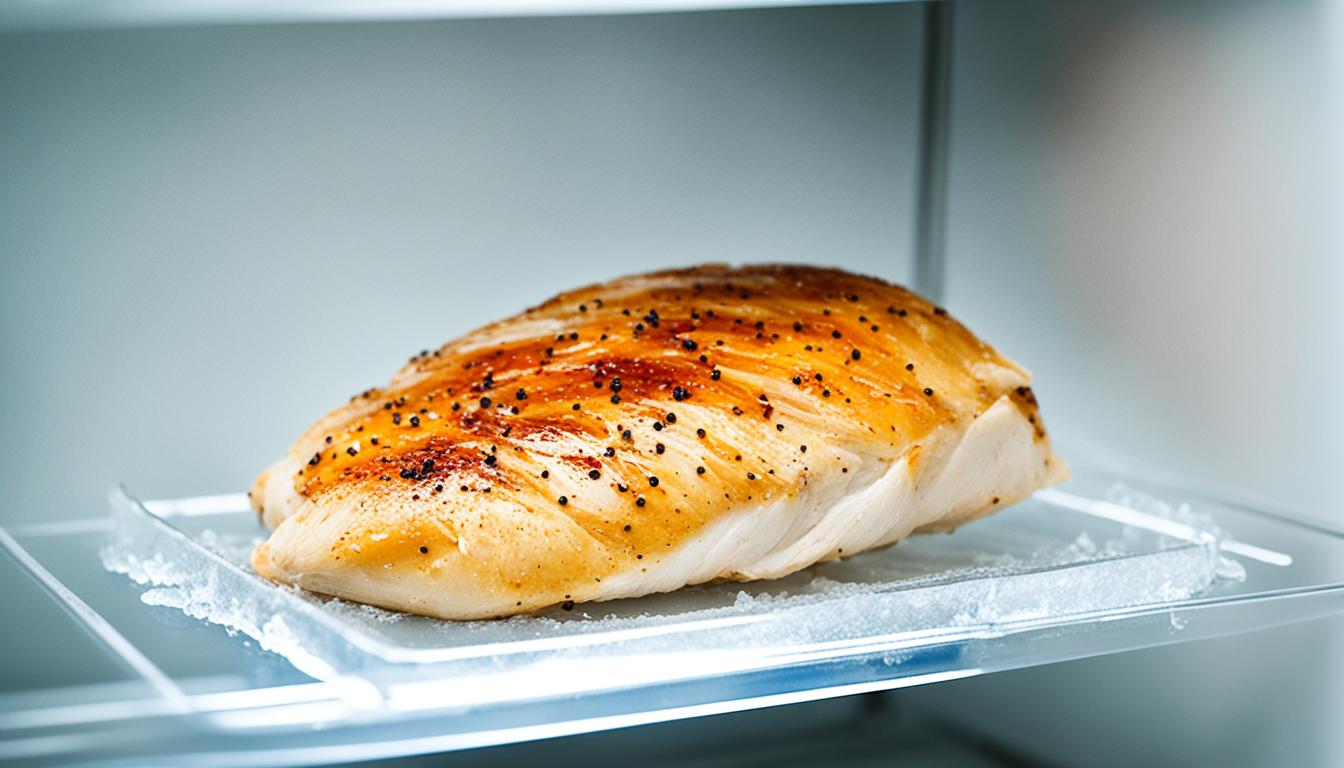If you’re in a rush and need to defrost chicken quickly, it’s important to know the right methods to ensure food safety and avoid harmful bacteria growth. In this article, we will explore some quick and easy ways to defrost chicken that will save you time and effort in the kitchen. Defrosting chicken properly is crucial for even cooking and to maintain its quality. So, let’s dive into some effective strategies for defrosting chicken fast!
How to Defrost Chicken in the Fridge?
When it comes to defrosting chicken, the safest and most recommended method is to use the fridge. This method allows the chicken to thaw gradually, minimizing the risk of bacterial growth and ensuring food safety. Here’s how to defrost chicken in the fridge:
- Place the chicken in a sealed sandwich bag to prevent any potential contamination.
- Put the chicken in the bottom section of the fridge to maintain a consistent temperature.
- Allow approximately 5 hours of defrosting time per 450g of chicken. It’s best to leave it overnight for thorough defrosting.
By defrosting chicken in the fridge, you can safely prepare it without compromising on taste or quality. Once the chicken is fully defrosted, it can be stored in the fridge for up to 24 hours before use.
The image above illustrates the process of defrosting chicken in the fridge. It serves as a visual guide to help you understand the steps involved.
| Method | Defrosting Time | Benefits |
|---|---|---|
| In the Fridge | Around 5 hours per 450g | Safe and gradual defrosting, minimizes bacterial growth |
| In Cold Water | About 1 hour | Quick defrosting option when time is limited |
| In the Microwave | Varies based on quantity | Convenient and rapid defrosting method |
The table above provides an overview of different defrosting methods, highlighting their respective defrosting times and benefits.
How to Defrost Chicken Quickly in Water?
If you need to defrost chicken quickly, the cold water method is a great option. This method allows you to thaw chicken in a short amount of time while ensuring food safety. Here’s how to defrost chicken quickly in water:
- Place the chicken in a sealed sandwich bag to prevent water from entering and contaminating the chicken.
- Fill a large bowl or basin with cold water. The water should be cold, not warm or hot, to prevent bacteria growth.
- Submerge the sealed bag of chicken in the cold water. Make sure the chicken is completely covered.
- Change the water every 30 minutes to keep it cold. This helps maintain the proper temperature for defrosting and ensures food safety.
- The chicken will defrost in about an hour, depending on the size and amount of chicken. It’s important to monitor the defrosting process to avoid over-thawing.
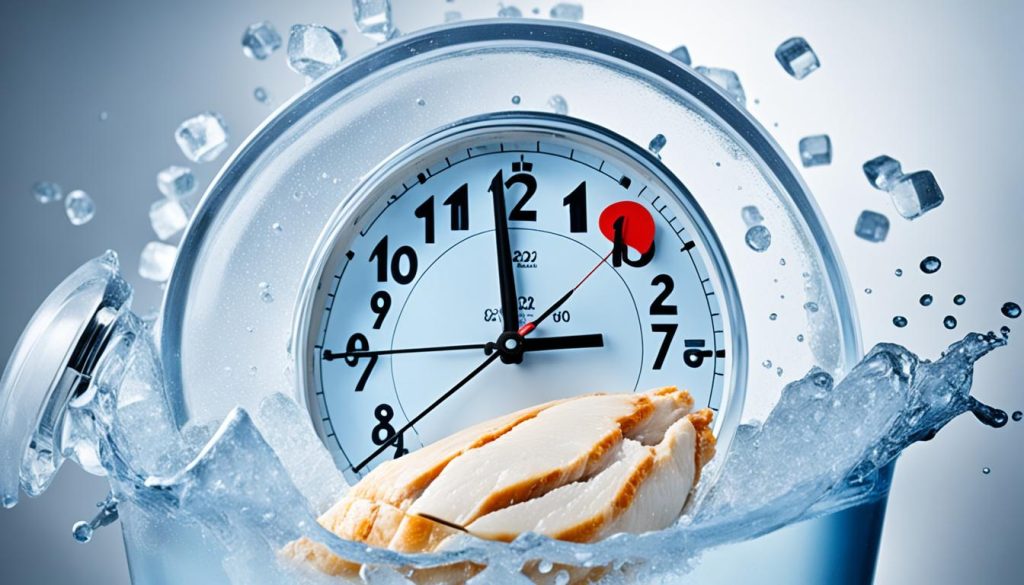
Once the chicken is fully defrosted, it should be cooked immediately. Avoid leaving the chicken at room temperature for an extended period, as this can encourage the growth of bacteria. By defrosting chicken quickly in water, you can save time without compromising food safety.
| Method | Time Required | Food Safety | Convenience |
|---|---|---|---|
| Defrosting in the fridge | Several hours to overnight | Safe | Convenient but requires advanced planning |
| Defrosting in cold water | About an hour | Safe if water is kept cold | Quick, but requires monitoring and changing water |
| Defrosting in the microwave | Varies based on microwave power | Safe if cooked immediately | Very quick, but may affect chicken texture |
How to Defrost Chicken in the Microwave?
When you’re short on time and need to defrost chicken quickly, the microwave can be your ally. With its convenience and speed, the microwave offers a practical solution for expedited chicken defrosting at home.
To defrost chicken in the microwave, follow these steps:
- Place the chicken on a microwavable plate.
- Set the microwave to the defrost or low power setting.
- Defrost the chicken for one minute at a time.
- Check the chicken regularly to assess its defrosting progress.
- Rotate the chicken and continue defrosting as needed until it is fully thawed.
It’s important to check the chicken regularly during the defrosting process to prevent overcooking or drying out. Microwaves vary in power, so adjusting the defrost time accordingly is crucial. Remember, the goal is to defrost the chicken, not to cook it in the microwave.
Once the chicken is fully defrosted, it’s essential to cook it immediately to ensure food safety. Avoid leaving defrosted chicken at room temperature for an extended period, as this can promote bacterial growth.
Pros and Cons of Microwave Defrosting
| Pros | Cons |
|---|---|
| Quick and convenient | Possibility of uneven defrosting |
| Retains most of the chicken’s moisture | Potential for partially cooked edges |
| Doesn’t require advance planning | May affect the texture of the chicken |
How to Tell When Chicken is Properly Defrosted?
Properly defrosting chicken is crucial to ensure safe and delicious meals. To determine if your chicken is properly defrosted, follow these simple steps:
1. Cut a small slit in the thickest part of the chicken
Use a clean knife to make a small incision in the thickest part of the chicken breast or thigh. This will allow you to assess the texture and appearance of the meat.
2. Check the texture of the flesh
Gently press the flesh around the incision. Properly defrosted chicken should feel soft and pliable. If the flesh is still firm or feels icy, it means that the chicken is not fully defrosted.
3. Look for ice crystals
Inspect the area around the incision for any remaining ice crystals. Ice crystals indicate that the chicken is still partially frozen. Properly defrosted chicken should be free from ice crystals.
By ensuring that your chicken is properly defrosted, you can avoid undercooking or overcooking and reduce the risk of foodborne illness. Remember to always thaw chicken safely to maintain its quality and safety.
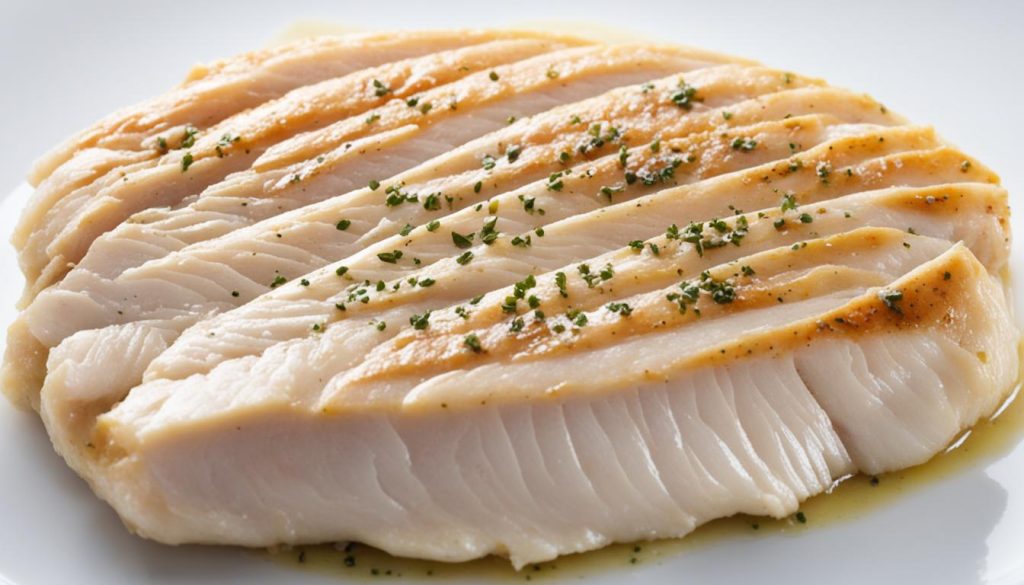
For a quick reference, here is a summary of how to tell when chicken is properly defrosted:
| Signs of Properly Defrosted Chicken | Signs of Insufficient Defrosting |
|---|---|
| The flesh is soft and pliable | The flesh is firm or feels icy |
| No ice crystals present | Ice crystals are still visible |
Checking for these signs will ensure that your chicken is ready to be cooked and enjoyed!
Can You Refreeze Defrosted Chicken?
If you have defrosted chicken in the fridge, it is safe to refreeze it within 1-2 days after thawing. However, refreezing may affect the quality of the chicken. If you have defrosted chicken using the microwave or in cold water, it must be cooked immediately and should not be refrozen. Following safe defrosting methods is important to maintain food safety standards.
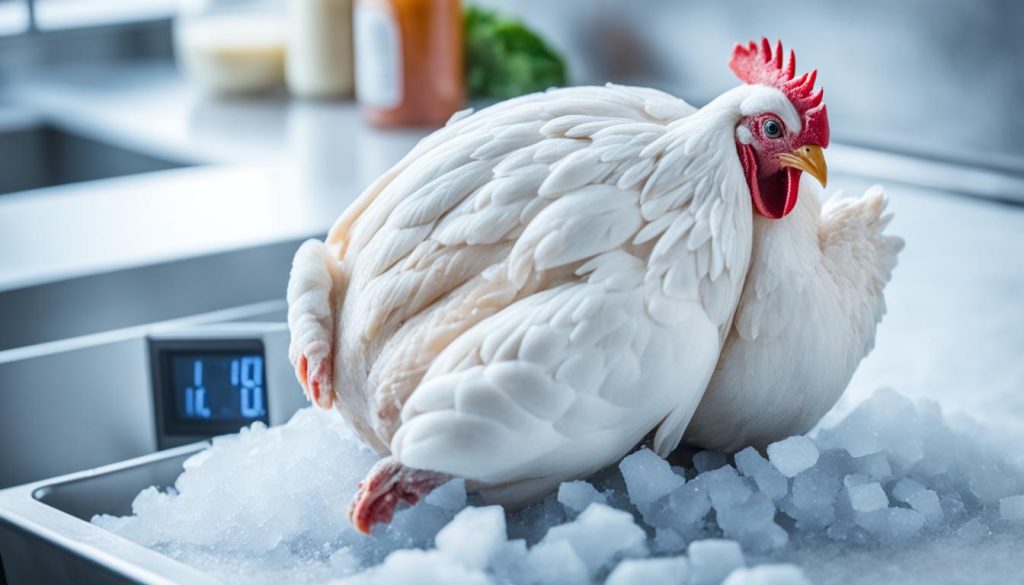
When it comes to defrosting chicken, there are a few important factors to consider. One of the most common questions that arise is whether you can refreeze defrosted chicken. The answer to this question depends on how the chicken was defrosted and the condition it is in.
If you have defrosted chicken in the fridge, which is the recommended method, you can safely refreeze it within 1-2 days after thawing. The fridge provides a controlled environment that minimizes bacterial growth while allowing the chicken to thaw gradually. However, it’s important to note that the quality of the chicken may be compromised after being frozen and thawed again. The texture and flavor may not be as good as fresh chicken.
On the other hand, if you have defrosted chicken using the microwave or in cold water, it is not safe to refreeze it without cooking. These methods of defrosting do not control the temperature of the chicken effectively, which can promote bacterial growth. Therefore, it is recommended to cook the chicken immediately after defrosting it using these methods.
Following safe defrosting methods is crucial to maintaining food safety standards. By defrosting chicken properly and avoiding refreezing after improper thawing, you can minimize the risk of foodborne illness and ensure the quality of the chicken.
Comparison of Defrosting Methods
| Defrosting Method | Safety | Quality |
|---|---|---|
| Refrigerator | Safe | Good |
| Microwave or Cold Water | Not safe for refreezing | N/A |
As shown in the table above, defrosting chicken in the fridge is the safest method and allows for refreezing within a specified time frame. However, using the microwave or cold water for defrosting does not allow for refreezing and requires immediate cooking. It’s crucial to prioritize food safety and follow the appropriate defrosting methods to ensure the well-being of yourself and others.
Top Tips for Defrosting Chicken and Preventing Foodborne Illness
In addition to the specific methods discussed, there are additional tips to ensure safe defrosting and prevent foodborne illness. By following these practices, you can maintain safe food handling practices and minimize the risk of contamination:
- Wash your hands: Always wash your hands before and after handling raw chicken to prevent the spread of bacteria. Use warm water and soap, and scrub your hands for at least 20 seconds. Proper hand hygiene is crucial for preventing cross-contamination and the spread of harmful pathogens.
- Store chicken properly: Proper chicken storage is key to maintaining its quality and safety. Keep chicken in the fridge or freezer at the appropriate temperature. Refrigerate raw chicken at or below 5°C (41°F) and freeze it at or below -18°C (0°F). Ensure that chicken is stored separately from other foods to prevent cross-contamination.
- Avoid defrosting at room temperature: Never defrost chicken at room temperature, as this can promote the growth of bacteria. Instead, use safe thawing methods such as defrosting in the fridge, using cold water, or using the microwave.
To further enhance food safety, consider the following tips:
- Cook chicken thoroughly: Always cook chicken thoroughly to kill any bacteria that may be present. Use a food thermometer to ensure that the internal temperature reaches a minimum of 75°C (165°F). Proper cooking kills harmful pathogens and ensures the chicken is safe to eat.
- Prevent cross-contamination: Avoid cross-contamination by using separate cutting boards and utensils for raw chicken and other ingredients. Sanitize surfaces and utensils after they come into contact with raw chicken to prevent the spread of bacteria.
- Store leftovers safely: If you have leftover cooked chicken, store it in airtight containers in the fridge or freezer. Consume refrigerated leftovers within 2-3 days and frozen leftovers within 2-3 months.
By following these top tips for safe defrosting and food handling practices, you can protect yourself and others from foodborne illnesses and enjoy chicken dishes without any worries.
Safe Minimum Internal Temperatures for Chicken
| Preparation | Temperature |
|---|---|
| Whole chicken (including parts) | 75°C (165°F) |
| Ground chicken | 74°C (165°F) |
| Chicken breasts, roasts, and thighs | 74°C (165°F) |
| Chicken wings and legs | 74°C (165°F) |
Remember, safe food handling practices and proper chicken storage are essential to prevent foodborne illness. By taking these precautions, you can enjoy delicious chicken meals while keeping yourself and your loved ones safe.
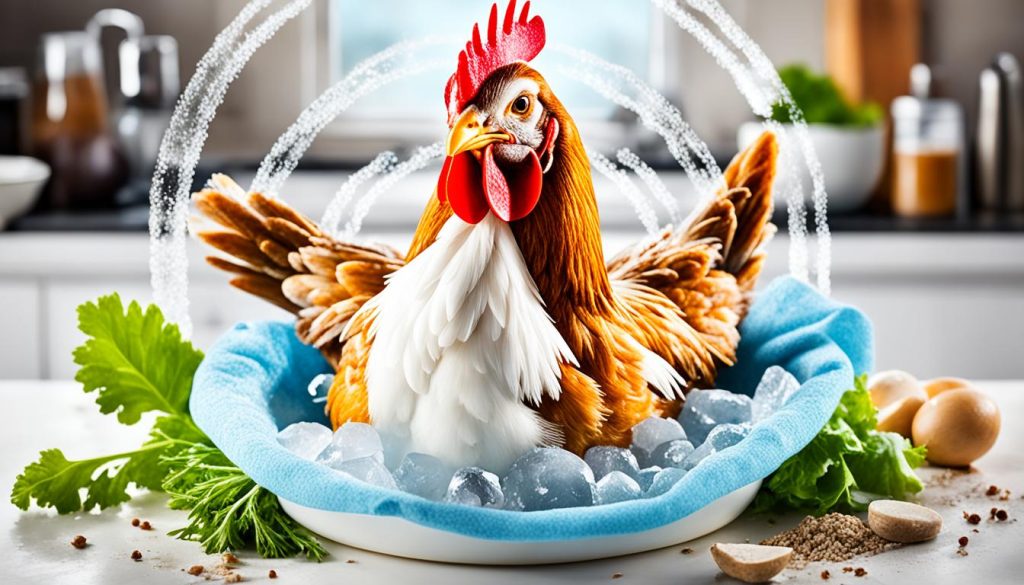
Conclusion
Efficient meal prep starts with defrosting chicken quickly and safely. The methods covered in this article offer practical and speedy ways to thaw chicken. Whether you choose to defrost in the fridge, use cold water, or utilize the microwave, these methods will have your chicken ready in no time. Remember to follow safe food handling practices and cook the chicken immediately after defrosting to ensure food safety. By incorporating these tips into your routine, you can expedite the chicken defrosting process without compromising on taste or safety.
Whether you need to defrost chicken breast quickly, want to try tips recommended on Reddit, use salt to speed up thawing, or prefer defrosting chicken in water, there are options for every situation. The key is to find the method that suits your needs and ensures food safety.
By understanding the various methods available and following the recommended techniques, you can confidently defrost chicken and create delicious meals. Say goodbye to the hassle of waiting hours for your chicken to defrost and embrace these effective and efficient methods. And remember, cooking chicken from frozen is possible but requires additional cooking time. It’s always best to defrost chicken properly for optimal taste and safety.

